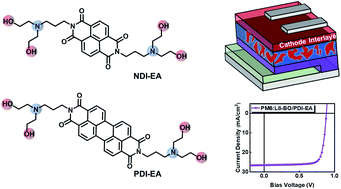Multi-site functional cathode interlayers for high-performance binary organic solar cells†
Abstract
A chemically robust and high-performance cathode interlayer material is imperative to further improve non-fullerene binary organic solar cell (OSC) efficiencies. Two bis(2-hydroxyethyl) amino-containing small molecules (NDI-EA and PDI-EA) are synthesized via a one-step condensation reaction between electron-deficient conjugated cores (i.e., perylene-diimide and naphthalene-diimide building blocks) and bis(2-hydroxyethyl) amino terminal groups. The bis(2-hydroxyethyl) amino groups serve as multi-modification sites to functionalize PDI-EA, enabling significant lowering of the work functions of cathode surfaces, remarkable electron conductivities, and excellent cathode/interlayer contact. In combination, these markedly enhance the photovoltaic properties. Upon modification by PDI-EA, PM6:Y6-based OSCs achieve a power conversion efficiency (PCE) exceeding 18%, and PM6:L8-BO-based OSCs give a PCE as high as 18.50%, among the highest values for binary organic photovoltaics. This material overcomes a key bottleneck in the use of the bis(2-hydroxyethyl) amino group in non-fullerene bulk heterojunction systems and uncovers the powerful use as multi-site functional cathode interlayers to enhance binary photoelectronic performances.



 Please wait while we load your content...
Please wait while we load your content...